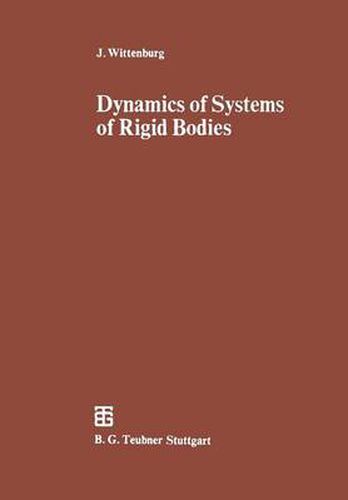Readings Newsletter
Become a Readings Member to make your shopping experience even easier.
Sign in or sign up for free!
You’re not far away from qualifying for FREE standard shipping within Australia
You’ve qualified for FREE standard shipping within Australia
The cart is loading…






This title is printed to order. This book may have been self-published. If so, we cannot guarantee the quality of the content. In the main most books will have gone through the editing process however some may not. We therefore suggest that you be aware of this before ordering this book. If in doubt check either the author or publisher’s details as we are unable to accept any returns unless they are faulty. Please contact us if you have any questions.
A system of rigid bodies in the sense of this book may be any finite number of rigid bodies interconnected in some arbitrary fashion by joints with ideal holonomic, nonholonomic, scleronomic and/or rheonomic constraints. Typical examples are the solar system, mechanisms in machines and living mechanisms such as the human body provided its individual members can be considered as rigid. Investigations into the dynamics of any such system require the formulation of nonlinear equations of motion, of energy expressions, kinematic relationships and other quantities. It is common practice to develop these for each system separately and to consider the labor necessary for deriving, for example, equations of motion from Lagrange’s equation, as inevitable. It is the main purpose of this book to describe in detail a formalism which substantially simplifies these tasks. The formalism is general in that it provides mathematical expressions and equations which are valid for any system of rigid bodies. It is flexible in that it leaves the choice of generalized coordinates to the user. At the same time it is so explicit that its application to any particular system requires only little more than a specification of the system geometry. The book is addressed to advanced graduate students and to research workers. It tries to attract the interest of the theoretician as well as of the practitioner.
$9.00 standard shipping within Australia
FREE standard shipping within Australia for orders over $100.00
Express & International shipping calculated at checkout
This title is printed to order. This book may have been self-published. If so, we cannot guarantee the quality of the content. In the main most books will have gone through the editing process however some may not. We therefore suggest that you be aware of this before ordering this book. If in doubt check either the author or publisher’s details as we are unable to accept any returns unless they are faulty. Please contact us if you have any questions.
A system of rigid bodies in the sense of this book may be any finite number of rigid bodies interconnected in some arbitrary fashion by joints with ideal holonomic, nonholonomic, scleronomic and/or rheonomic constraints. Typical examples are the solar system, mechanisms in machines and living mechanisms such as the human body provided its individual members can be considered as rigid. Investigations into the dynamics of any such system require the formulation of nonlinear equations of motion, of energy expressions, kinematic relationships and other quantities. It is common practice to develop these for each system separately and to consider the labor necessary for deriving, for example, equations of motion from Lagrange’s equation, as inevitable. It is the main purpose of this book to describe in detail a formalism which substantially simplifies these tasks. The formalism is general in that it provides mathematical expressions and equations which are valid for any system of rigid bodies. It is flexible in that it leaves the choice of generalized coordinates to the user. At the same time it is so explicit that its application to any particular system requires only little more than a specification of the system geometry. The book is addressed to advanced graduate students and to research workers. It tries to attract the interest of the theoretician as well as of the practitioner.